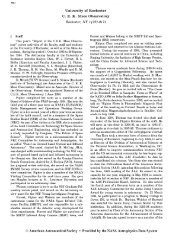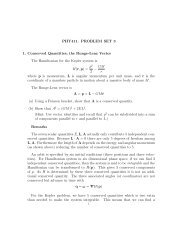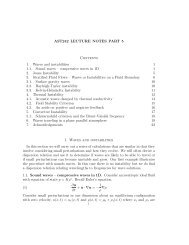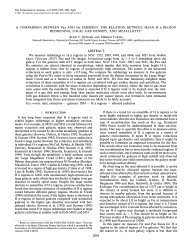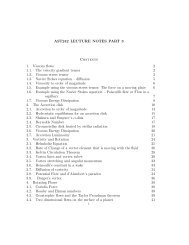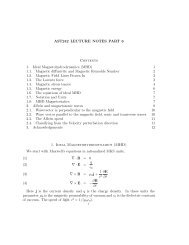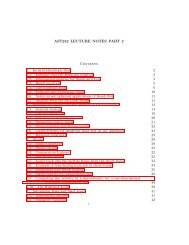Lab 1 â Measurements of Frequency - Astro Pas Rochester
Lab 1 â Measurements of Frequency - Astro Pas Rochester
Lab 1 â Measurements of Frequency - Astro Pas Rochester
You also want an ePaper? Increase the reach of your titles
YUMPU automatically turns print PDFs into web optimized ePapers that Google loves.
Physics <strong>of</strong> Music PHY103 <strong>Lab</strong> Manual<br />
than all the rest and connects with BNC and no leads. If you are at this lab set up the counter<br />
should simply show you the frequency in Hz (though I think there is also a reset button).<br />
3. In the counter module flip the black mode switch (up and down switch) to measure frequency<br />
(kHz) (bottom position). Note 1kHz is 1000 Hz.<br />
4. In your notebook, record the value you obtain for the frequency measured by the counter.<br />
5. You can make a more accurate measurement by setting the counter module to counter (middle<br />
position for the black mode switch). The set the counter to 1s (this is the horizontal switch in the<br />
counter section). On the upper right press the START/STOP button. The counter should measure<br />
the number <strong>of</strong> pulses in 1s. To make another measurement, you can press RESET (button on top<br />
left) before you start the counter again. You can do this a number <strong>of</strong> times and compute an<br />
average value.<br />
Part IV – Additional <strong>Measurements</strong><br />
1. Carry out about ten similar trials at different frequencies. For example at 1000 and 5000 Hz or<br />
other frequencies that you might choose. For these additional trials use the three methods<br />
(function generator, counter and oscilloscope) to record or estimate frequencies. In your lab<br />
report you will discuss differences between the frequency measurements and your feelings about<br />
the uncertainties in these measurements.<br />
Part V – Looking at the output <strong>of</strong> the microphone on the oscilloscope.<br />
1. Connect the output <strong>of</strong> the pre-amp into an input <strong>of</strong> the oscilloscope. You will need an adapter<br />
(male BNC to female 1/4” audio) that should be part <strong>of</strong> the equipment on the desk.<br />
2. Make sure that your microphone is connected to the preamp and that the preamp is plugged in.<br />
The green power indicator should light up. The +48V button should be pushed in. This powers<br />
the microphone that employs a capacitor. The capacitor creates an electric field between two<br />
plates. The plates respond to small pressure variations (such as those made by sound waves)<br />
creating a signal that is amplified by the preamp and passed on to the computer. Powered<br />
microphones are usually superior to un-powered ones.<br />
3. Play a sound from the computer speaker or by connecting the function generator to the open<br />
speaker. If you use the function generator you can send that signal into channel 2 <strong>of</strong> the<br />
oscilloscope and display both the signal from the microphone and that from the function generator<br />
together.<br />
4. Compare the output <strong>of</strong> the preamp (fed by the microphone) to the signal from the function<br />
generator. You can adjust the strength <strong>of</strong> the microphone output with the dials on the preamp.<br />
This signal should be stronger than that you will see by using the speaker as a microphone in the<br />
next lab.<br />
5. Try singing or speaking into the microphone while looking at the signal on the oscilloscope. Can<br />
you sing notes that cause the microphone signal to be a periodic signal even with the speaker on?<br />
(Pure intervals such as octaves or fifths or thirds?)<br />
Part VI – Your body as a conductor and Antenna.<br />
1. Remove the BNC cable from the CH1 input. Plug in the oscilloscope probe into CH 1.<br />
2. Touch the end <strong>of</strong> the oscilloscope with your finger.<br />
3. Adjust the Ch 1 VOLTS knob so that you can see a signal. While your body is a pretty good<br />
antenna, you don’t actually pick up a large voltage. You can use the oscilloscope to look at very<br />
small voltages and you will need to do so to see a signal.<br />
4. Adjust the TIME/CM knob to very small time intervals. You should see a lot <strong>of</strong> high frequency<br />
noise.<br />
5. Adjust the TIME/CM knob to larger time intervals. Look for a sine wave pattern in the noise.<br />
Your body is picking up a pretty strong low frequency signal. What is this frequency coming<br />
from? Measure its frequency to see if the frequency itself gives you a clue. Hint given at the end<br />
<strong>of</strong> the lab. *




